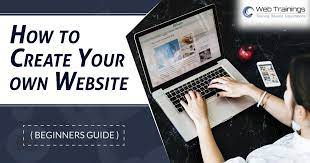Creating a website is a crucial step in establishing an online presence. Whether it's for personal use, a business, or a passion project, learning how to create a website can seem daunting for beginners. However, with the right guidance and tools, the process becomes more manageable. In this comprehensive guide, we'll walk you through the essential steps to create your own website from scratch.
What is a Website?
A website is a collection of web pages that are interconnected and accessible via the internet. These pages can contain various forms of content such as text, images, videos, and more. Websites serve as a platform to showcase information, products, services, or personal interests to a global audience.
Planning Your Website
Before diving into the technical aspects, planning is crucial. Determine the purpose of your website, target audience, and the type of content you wish to present. Sketch out the layout and structure to visualize how your site will look.
Content Management Systems (CMS)
Selecting the appropriate platform is fundamental. Content Management Systems like WordPress, Wix, or Squarespace offer user-friendly interfaces, templates, and plugins that simplify the website building process for beginners. Evaluate the features and choose one that aligns with your requirements.
Registering a Domain Name
The domain name is your website's address on the internet (e.g., www.yourwebsite.com). Choose a name that is relevant, memorable, and reflective of your brand or content.
Web Hosting
Web hosting is where your website's files are stored and accessed. Choose a reliable hosting provider that offers security, speed, and uptime guarantees.
Customizing Templates and Themes
Most CMS platforms provide templates and themes that you can customize to match your brand or style. Consider the layout, color scheme, typography, and overall aesthetics of your website.
Adding Content
Create compelling and engaging content that resonates with your audience. Utilize high-quality images, well-written text, and multimedia elements to enhance user experience.
User-friendly Navigation
A well-organized site structure with intuitive navigation is vital for a positive user experience. Ensure easy access to different pages and sections of your website.
Functionality and Responsiveness
Optimize your website for different devices (desktop, mobile, tablet) to ensure it looks and functions seamlessly across all platforms. A responsive design is critical for user satisfaction.
Search Engine Optimization (SEO)
Implement SEO strategies such as keyword optimization, meta tags, alt text for images, and creating valuable content that ranks higher in search engine results.
Testing Your Website
Before launching, perform thorough testing to check for errors, broken links, and overall functionality. Use tools like Google Analytics to monitor site performance.
Launching Your Website
Once satisfied with the testing, it's time to launch your website. Announce it through social media, email newsletters, or other marketing channels to attract visitors.
Regular Updates
Regularly update your content, fix bugs, and implement security measures to keep your site fresh and secure.
Analyzing Performance
Continuously monitor your website's performance using analytics tools. Analyze visitor data to understand user behavior and make improvements accordingly.
Conclusion
Creating a website may seem complex at first, but with the right guidance and persistence, anyone can master it. Follow these steps, stay consistent, and watch your online presence flourish.


No comments yet